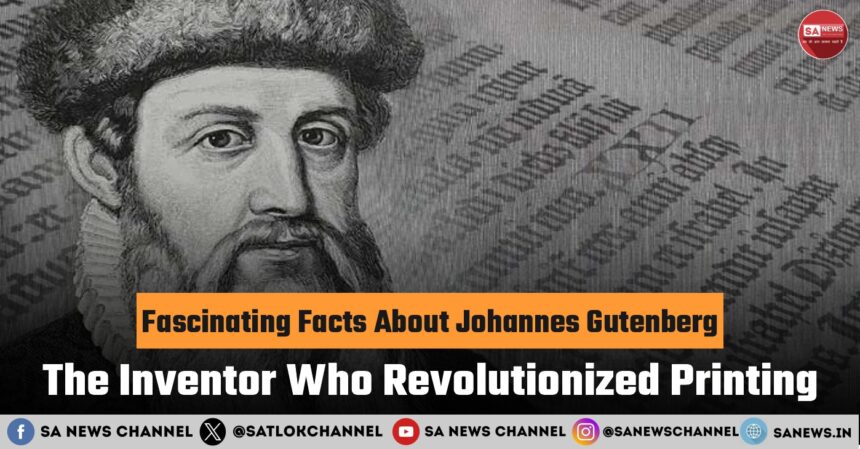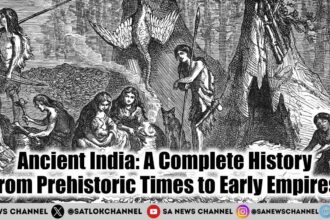Revolutionizing the world of printing, Johannes Gutenberg is a name synonymous with innovation. His groundbreaking invention changed how we share information. It played a key role in spreading knowledge during the Renaissance.
- Key Takeaways on Johannes Gutenberg
- The Historical Context of 15th Century Europe
- Who Was Johannes Gutenberg?
- Fact 1: Johannes Gutenberg Didn’t Invent Printing Itself
- Fact 2: The Ingenious Mechanics of Gutenberg’s Press
- Fact 3: The Gutenberg Bible Was a Commercial Project
- Fact 4: Gutenberg Lost Everything in a Lawsuit
- Fact 5: Gutenberg Died in Relative Obscurity
- The Printing Revolution’s Global Impact
- Modern Printing Technologies: Gutenberg’s Legacy
- Commemorations and Cultural Impact
- Conclusion: Why Gutenberg’s Innovation Matters in the Digital Age
- FAQ
- Who is Johannes Gutenberg and why is he significant?
- What was the printing revolution, and how did it impact society?
- What was Gutenberg’s contribution to the development of the printing press?
- What is the significance of the Gutenberg Bible?
- How did the printing press influence the spread of knowledge and literacy?
- What were some of the challenges faced by Gutenberg in developing his printing press?
- How did Gutenberg’s innovation impact the development of modern printing technologies?
- What is Gutenberg’s legacy, and how is he remembered today?
Gutenberg did more than just invent the printing press. He was a true pioneer, leaving a lasting legacy in communication. This article will explore five fascinating facts about Gutenberg, shedding light on his life and achievements.
Key Takeaways on Johannes Gutenberg
- Gutenberg’s printing press was a revolutionary invention.
- His innovation had a significant impact on the spread of knowledge.
- Gutenberg’s legacy extends beyond his printing press.
- He played a key role in the Renaissance.
- Gutenberg’s contributions to society are celebrated today.
The Historical Context of 15th Century Europe
The 15th century was a key time for Europe. It saw big changes in society, economy, and culture. These changes helped shape the printing technology we know today.
This era wanted to share information better. More people could read, and education was getting more important.
Medieval Information Sharing Before the Press
Before the printing press, sharing info in medieval Europe was hard. It used handwritten manuscripts. Scribes copied texts by hand, taking a lot of time.
Historian Elizabeth Eisenstein said, “The coming of printing was a major event in the early modern era. It made sharing ideas easier and helped people become more educated.”
“The advent of printing was a major event… for it made possible the wide dissemination of ideas.”
This old way was slow and costly. Books were rare and only for the rich.
The Socioeconomic Climate of Mainz
Mainz, where Gutenberg grew up, was a big deal in 15th-century Europe. It was rich and important in trade. The city’s wealth and growing population were perfect for new ideas.
| Factor | Description | Impact on Gutenberg |
| Economic Prosperity | Mainz was a wealthy city with a strong trade network. | Provided financial backing for Gutenberg’s project. |
| Cultural Significance | Mainz was a center of learning and culture. | Created a demand for printed materials. |
| Technological Innovation | Mainz was at the forefront of technological advancements. | Influenced the development of the printing press. |
Mainz’s mix of wealth, culture, and tech was key for Gutenberg’s press. It changed how info spread across Europe.
Who Was Johannes Gutenberg?
Gutenberg is often called the inventor of the printing press. His early life and career were key to his famous invention. Let’s look at his background and what led to the printing press.
Early Life and Family Background
Johannes Gutenberg was born around 1398 in Mainz, Germany. His family was wealthy and well-connected. His father was a merchant and part of the local aristocracy.
This upbringing gave Gutenberg financial stability and social connections. He learned about business and trade early on.
Career Before the Printing Press
Gutenberg had several jobs before inventing the printing press. These jobs helped shape his printing innovation.
Goldsmithing Apprenticeship
Gutenberg learned to be a goldsmith first. This training was key to his later work. He learned metalworking and precision.
Entrepreneurial Ventures
Gutenberg also had other jobs, like political mirroring and metal polishing. These jobs showed his creativity and ability to spot opportunities. They helped him succeed with the printing press.
Gutenberg’s early life, family, and jobs before the printing press were important. His experiences and skills led to the printing press. This printing innovation changed the world.
Fact 1: Johannes Gutenberg Didn’t Invent Printing Itself
Johannes Gutenberg is often credited with inventing the printing press. But, the truth is more complex. Printing had been around for centuries before Gutenberg.
Ancient Printing Methods in Asia
Printing started in ancient Asia. Woodblock printing was first seen in China during the Tang Dynasty, around 700 AD. It involved carving text or images into wooden blocks, inking them, and then transferring the ink to paper or fabric.
In China’s Song Dynasty (960-1279 AD), Bi Sheng created the first known movable type. His type pieces were made of ceramic materials, but they were fragile and not very durable.
Gutenberg’s True Innovation
Gutenberg’s big contribution was not inventing printing. Instead, he made a more efficient and durable movable type printing system. This innovation changed how information spread in Europe.
Combining Existing Technologies
Gutenberg mixed old technologies to make his printing press. He used the screw design of wine presses for printing. This made it possible to print lots of materials at once.
The Metal Alloy Breakthrough
Gutenberg also created a strong metal alloy for his type pieces. This alloy, made from lead, tin, and antimony, was pivotal for a practical movable type system.
| Printing Method | Characteristics | Historical Context |
| Woodblock Printing | Text or images carved into wood, inked, and transferred to paper or fabric | Tang Dynasty, China (700 AD) |
| Bi Sheng’s Movable Type | Ceramic type pieces, fragile and less durable | Song Dynasty, China (960-1279 AD) |
| Gutenberg’s Movable Type | Metal alloy type pieces, durable and efficient | 15th Century, Europe |
Gutenberg’s movable type printing system was a big change. It made it easy to print books, pamphlets, and more. This helped spread knowledge during the Renaissance and beyond.
Fact 2: The Ingenious Mechanics of Gutenberg’s Press
Gutenberg’s press was a masterpiece of engineering. It had many parts that worked together. This made it a game-changer in printing.
The Movable Type System Explained
The movable type system was key to Gutenberg’s press. It let him change and reuse letters. This made printing much faster than before.
Type Casting Process
To make characters, Gutenberg used a mold. This made each letter the same. He used a mix of lead and tin, which was strong and good for printing.
Page Composition Techniques
Putting text on pages was a big job. It needed skill to get the text right. Every line and page had to be perfect.
The Modified Wine Press Mechanism
Gutenberg made the wine press work for printing. This was key for making prints clear.
Pressure Distribution Innovation
Gutenberg’s press spread ink evenly. This was thanks to its design and a flat surface. It made prints clear and consistent.
Ink Formulation Secrets
Gutenberg made a special ink. It stuck well to metal and paper. His ink was oil-based, lasting a long time.
| Innovation | Description | Impact |
| Movable Type | Allowed for individual characters to be rearranged and reused. | Significantly increased printing efficiency. |
| Type Casting | Created uniform characters using a lead-tin alloy. | Improved text quality and durability. |
| Pressure Distribution | Ensured even pressure across the page. | Produced clear and consistent prints. |
| Ink Formulation | Developed oil-based ink for better adhesion and durability. | Enhanced print quality and longevity. |
Fact 3: The Gutenberg Bible Was a Commercial Project
The Gutenberg Bible is seen as a printing masterpiece. It was started as a way to make money. Johannes Gutenberg’s creativity and business skills made it happen around 1455.
Financing the First Print Run
Gutenberg needed a lot of money for his big project. Johann Fust, a merchant, saw the value in Gutenberg’s printing tech.
The Partnership with Johann Fust
Gutenberg teamed up with Johann Fust for funding. Fust gave the money, but the deal wasn’t good for Gutenberg. This led to future problems.
Production Costs and Challenges
Making the Gutenberg Bible was expensive and hard. Thousands of metal type pieces, ink, and a special press were needed. The costs were high, and the work was tricky.
Artistic Elements of the Gutenberg Bible
Even though it was made to sell, the Gutenberg Bible is famous for its beauty. Its design shows Gutenberg’s skill in printing and taste in art.
Typography and Layout Innovations
The Gutenberg Bible brought new printing ideas. It used movable type for quick text making. The design was like old manuscripts, with fancy borders and letters.
The Surviving Copies Today
Now, less than 50 copies of the Gutenberg Bible exist. They are very rare and valuable. Scholars and collectors around the world study and admire them.
Fact 4: Gutenberg Lost Everything in a Lawsuit
Johannes Gutenberg, the pioneer of the printing revolution, faced a big setback. A legal battle drained his money. Despite his big contributions, his financial stability was shaken.
Also Read: Alexander Graham Bell, The Story of the Man Who Gave Voice to the World: Early Life and Childhood
The Legal Battle with Johann Fust
Gutenberg’s troubles started with a lawsuit from Johann Fust. Fust was a financier who helped Gutenberg. He wanted his loan back, but Gutenberg couldn’t pay because of his printing costs.
The fight in court was tough. Sadly, the court sided with Fust. This put a big strain on Gutenberg’s finances.
Bankruptcy and Later Years
The lawsuit with Fust made Gutenberg bankrupt. But he didn’t stop working on his printing press. He did it on a smaller scale.
In his later years, Gutenberg faced many challenges. But his work on the printing revolution left a lasting mark.
Court Records and Documentation
Court records from back then show the fight between Gutenberg and Fust. These documents give us a peek into the financial and legal troubles Gutenberg faced.
| Year | Event | Impact |
| 1455 | Lawsuit filed by Johann Fust | Financial strain on Gutenberg |
| 1460s | Gutenberg’s bankruptcy | Loss of possessions |
| 1465 | Recognition by the Archbishop | Honor and some financial relief |
Final Recognition from the Archbishop
In 1465, Gutenberg got recognition from the Archbishop of Mainz. This brought him some honor and helped his finances. This recognition came late in his life, after many challenges.

printing revolution
Gutenberg’s story shows the personal costs of innovation and the printing revolution he started.
Fact 5: Gutenberg Died in Relative Obscurity
Johannes Gutenberg’s life ended in quiet, unlike his huge impact on printing. He changed the world with his printing innovation. Yet, his later years were not widely known.
The Lack of Recognition in His Lifetime
Gutenberg’s invention was groundbreaking but didn’t make him famous or rich. The printing press needed a lot of money and skill. Many people didn’t see how big his idea was.
The slow adoption of his technology in different places was a big reason. This was because of low literacy and a lack of skilled workers.
How History Eventually Recognized His Genius
As time went on, people saw how big the printing press was. Historians and scholars started to see Gutenberg’s role in spreading knowledge. They realized he was a key figure in history.
Rediscovery of Gutenberg’s Importance
The rediscovery of Gutenberg’s importance came as people learned more about the printing press. Historians dug deep into printing’s history. They found out how big Gutenberg’s work was.
Modern Scholarly Assessment
Today, scholars know Gutenberg was a true pioneer in printing. His use of movable type and the press was a big step forward. It helped printing technology grow even more.
| Aspect | Gutenberg’s Innovation | Impact |
| Movable Type | Allowed for efficient rearrangement of characters | Enabled mass production of printed materials |
| Press Mechanism | Adapted from wine presses, applied to printing | Facilitated the widespread dissemination of knowledge |
| Standardization | Introduced consistency in printed texts | Improved readability and facilitated education |
The Printing Revolution’s Global Impact
The printing revolution, started by Johannes Gutenberg’s press, changed the world. It made reading and sharing knowledge easier. This change affected many parts of society.
Explosion of Literacy Across Europe
The printing press made more people read in Europe. Books were cheaper and easier to find. This helped more people learn to read.
This boost in reading helped education and social status. It opened doors for many.
Democratization of Knowledge
The printing press made knowledge available to all. Before, only the rich and clergy could read. Now, books were for everyone.
Religious Reformation Connections
The printing press helped spread Reformation ideas. Leaders like Martin Luther could share their views. This challenged the Catholic Church.
Scientific Revolution Enablement
The press also helped the Scientific Revolution. Scientists could share their findings. This led to new ideas and discoveries.
“The printing press was a major factor in the spread of knowledge during the Renaissance and Reformation periods.”
— Elizabeth Eisenstein, historian
The table below shows how printing presses grew in Europe:
| Year | Number of Printing Presses | Locations |
| 1450 | 1 | Mainz, Germany |
| 1500 | 200-250 | Various cities across Europe |
In conclusion, the printing revolution changed Europe. It increased literacy, spread knowledge, and sparked cultural and intellectual movements.
Modern Printing Technologies: Gutenberg’s Legacy
Gutenberg’s movable type printing press changed how we share knowledge. It led to today’s printing tech, like digital and 3D printing.
Evolution from Movable Type to Digital Printing
The move from Gutenberg’s movable type to digital printing took a long time. Important steps include:
- The start of offset printing in the 20th century, making lots of printed stuff possible.
- The arrival of digital printing, which cut down on the need for plates and allowed for quick prints.
- The creation of inkjet and laser printers for both personal and business use.
Principles That Remain Unchanged
Even with all the new tech, some things stay the same. The basic idea of Gutenberg’s movable type is key. Today’s printing tech keeps using:
- Modularity: Mixing different parts (characters, images) to make a page.
- Reusability: Using the same parts over again to save money.
- Precision: Needing exact placement for top-notch prints.
These ideas show how Gutenberg’s work is part of today’s printing world.
Commemorations and Cultural Impact
Johannes Gutenberg’s work is celebrated worldwide. His printing press invention has left a lasting mark. It shapes our culture today.
Museums and Monuments
Many museums and monuments honor Gutenberg. The Gutenberg Museum in Mainz, Germany, is a key place. It shows the history of printing with artifacts, including a press replica.
Gutenberg in Popular Culture
Gutenberg’s impact is seen in books, movies, and media.
Literary References
Gutenberg is often mentioned in books. He stands for knowledge and new ideas. For example,
“Gutenberg’s press was not only a technological marvel but a catalyst for the Renaissance and the Protestant Reformation.”
Authors talk about Gutenberg’s role in changing society.
Films and Media Portrayals
Gutenberg’s life has been made into movies and documentaries. These stories show his hard work and creativity. They make his story known to many.
| Year | Title | Type |
| 2016 | Gutenberg: The Movie | Documentary |
| 2007 | Print the Legend | Documentary |
Conclusion: Why Gutenberg’s Innovation Matters in the Digital Age
Johannes Gutenberg’s invention of the movable-type printing press changed how we share information worldwide. It’s key to know about this in today’s digital world.
The printing press made books easier to make, boosting literacy and sharing knowledge. This helped start big cultural and intellectual changes. Now, as digital printing grows, Gutenberg’s ideas on making lots of copies are just as important.
Gutenberg’s work has inspired many innovators and thinkers. His work helps us keep improving technology and how we talk to each other. We thank Johannes Gutenberg for starting the modern information age.
FAQ
Who is Johannes Gutenberg and why is he significant?
Johannes Gutenberg was a German goldsmith and printer. He invented the movable type printing press. This innovation changed how we share knowledge and played a big role in the Renaissance and Protestant Reformation.
What was the printing revolution, and how did it impact society?
The printing revolution started in the 15th century with the printing press. It made it easy to print lots of materials. This led to more people learning to read and sharing knowledge, helping the Scientific Revolution and Religious Reformation.
What was Gutenberg’s contribution to the development of the printing press?
Gutenberg made the printing press better by using movable type. This means each letter was cast in metal and could be changed to print different pages. It made printing faster and more efficient.
What is the significance of the Gutenberg Bible?
The Gutenberg Bible was printed around 1455. It was the first big book made with Gutenberg’s press. It showed how well the technology could make quality texts for many people.
How did the printing press influence the spread of knowledge and literacy?
The printing press helped make lots of books. This led to more people learning to read. More written materials meant a big increase in knowledge and learning.
What were some of the challenges faced by Gutenberg in developing his printing press?
Gutenberg had many challenges. He had to find the right metal for the type, make a press that worked well, and create ink that stuck. He also faced money problems and a lawsuit with Johann Fust.
How did Gutenberg’s innovation impact the development of modern printing technologies?
Gutenberg’s movable type printing started a chain of improvements in printing. It led to modern printing methods, including digital printing. His work is a key part of printing history.
What is Gutenberg’s legacy, and how is he remembered today?
Gutenberg is seen as a pioneer in printing. His work is celebrated for spreading knowledge, improving literacy, and enriching culture. Many museums, monuments, and cultural references honor him.









